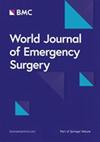预防性PICO◊敷料缩短了紧急开腹手术后伤口敷料的需求(EL-PICO◊试验)
IF 5.8
1区 医学
Q1 EMERGENCY MEDICINE
引用次数: 0
摘要
手术部位感染(SSI)是急诊开腹手术中非常常见的并发症,会导致严重的发病率。PICO◊设备可为闭合切口提供负压伤口疗法(NPWT),一些研究表明该设备可在不同手术人群中起到预防SSI的作用。我们的目的是比较急诊开腹手术后接受PICO◊和传统敷料的患者的SSI感染率。次要目标是观察血清肿和开裂率、住院时间、敷料使用天数和患者的伤口体验。这项双盲随机对照试验于2019年10月至2022年3月期间在马来亚大学医疗中心进行。研究对象包括接受急诊开腹手术、切口小于35厘米的患者。统计分析对分类变量采用χ2检验,对参数或非参数数据分别采用独立T检验或曼-惠特尼U检验,此外还采用逻辑回归。P 值小于 0.05 视为显著。共分析了 96 名患者(47 名干预者,49 名对照者)。干预组(PICO◊)与对照组的敷料持续时间更为一致[9.78 ± 10.20 vs 17.78 ± 16.46天,P < 0.001]。干预组的 SSI [14.3% vs 4.3%,P = 0.09]、开裂 [27.1% vs 10.6%,P = 0.07]和血清肿 [40.8% vs 23.4%,P = 0.08]发生率呈下降趋势,但未达到统计学意义。两组患者的住院时间[9(IQR:6-14)天 vs 11(IQR:6-22.5)天,P = 0.18]相当接近,但与传统敷料相比,更多患者对PICO◊非常满意[80% vs 57.1%,P = 0.03]。在急诊开腹手术中使用NPWT可改善患者的伤口护理体验,并有减少伤口相关并发症的趋势。为了进一步验证 NPWT 在急诊环境中的使用效果,尤其是对有 SSI 额外风险的患者,还需要对其成本效益进行探讨。试验注册国家医学研究注册中心(NMRR):NMRR-20-1975-55222。本文章由计算机程序翻译,如有差异,请以英文原文为准。
Prophylactic PICO◊ dressing shortens wound dressing requirements post emergency laparotomy (EL-PICO◊ trial)
Surgical site infection (SSI) is a very common complication of emergency laparotomy and causes significant morbidity. The PICO◊ device delivers negative pressure wound therapy (NPWT) to closed incisions, with some studies suggesting a role for prevention of SSI in heterogenous surgical populations. We aimed to compare SSI rates between patients receiving PICO◊ versus conventional dressing post-emergency laparotomy. Secondary objectives were to observe seroma and dehiscence rates, length of stay, days on dressing and patients’ wound experience. This double blinded randomized controlled trial was conducted in University Malaya Medical Centre between October 2019 and March 2022. Patients undergoing emergency laparotomy requiring incisions less than 35 cm were included. Statistical analysis was performed using χ2 test for categorical variables, independent T-test or Mann–Whitney U were used for parametric or non-parametric data respectively besides logistic regression. P values of < 0.05 were considered to be significant. Ninety-six patients were analyzed (47 interventions, 49 controls). The duration on dressing was more consistent in the intervention arm (PICO◊) versus control arm [9.78 ± 10.20 vs 17.78 ± 16.46 days, P < 0.001]. There was a trend towards lower SSI [14.3 vs 4.3%, P = 0.09], dehiscence [27.1 vs 10.6%, P = 0.07] and seroma [40.8 vs 23.4%, P = 0.08] rates in the intervention arm but this did not reach statistical significance. Length of stay [9 (IQR: 6–14) vs 11 (IQR: 6–22.5) days, P = 0.18] was fairly similar between the two arms, but more patients were very satisfied with PICO◊ compared to the conventional dressing [80% vs 57.1%, P = 0.03]. The use of NPWT in emergency laparotomy improves patients wound care experience, and was associated with trends towards fewer wound related complications. Cost effectiveness needs to be explored in order to further validate its use in the emergency setting, especially for patients with additional risk for SSI. Trial registration National Medical Research Registry (NMRR): NMRR-20-1975-55222.
求助全文
通过发布文献求助,成功后即可免费获取论文全文。
去求助
来源期刊

World Journal of Emergency Surgery
EMERGENCY MEDICINE-SURGERY
CiteScore
14.50
自引率
5.00%
发文量
60
审稿时长
10 weeks
期刊介绍:
The World Journal of Emergency Surgery is an open access, peer-reviewed journal covering all facets of clinical and basic research in traumatic and non-traumatic emergency surgery and related fields. Topics include emergency surgery, acute care surgery, trauma surgery, intensive care, trauma management, and resuscitation, among others.
 求助内容:
求助内容: 应助结果提醒方式:
应助结果提醒方式:


